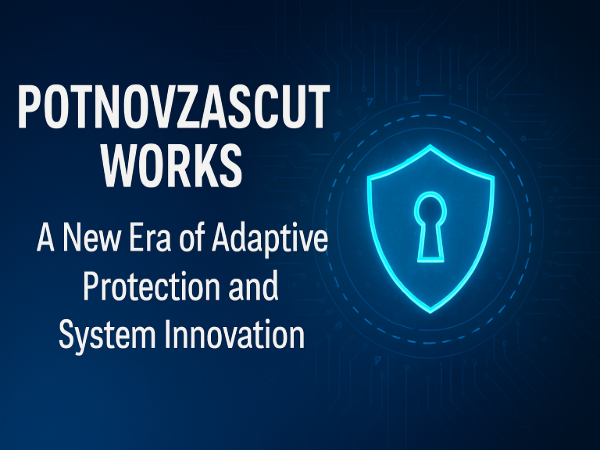Potnovzascut Works – A New Era of Adaptive Protection and System Innovation
Understanding How the Concept of Potnovzascut Works Blends Security, Adaptability, and Resilience in Modern Systems

The term Potnovzascut Works refers to an emerging conceptual framework that integrates protection, adaptability, and innovation to enhance system resilience. It focuses on creating mechanisms that not only defend against disruptions but also enable systems to adapt, evolve, and recover dynamically. While still new and not formally standardized, Potnovzascut Works has gained attention in discussions around cybersecurity, automation, and adaptive system design. It represents a forward-thinking approach that balances security with flexibility, making it an intriguing model for future technological and organizational growth.
Introduction to Potnovzascut Works
In an era where technology is evolving faster than ever, the need for systems that can both protect themselves and adapt to change has become critical. Potnovzascut Works is a concept that embodies this dual requirement. Although the term may sound unconventional, its meaning is rooted in the balance between safeguarding structures and allowing them to grow through innovation. The framework highlights a shift in mindset—from rigid security to adaptive protection—where systems are designed not just to defend against threats but to evolve and thrive amid uncertainty.
This innovative perspective has drawn interest from cybersecurity experts, system designers, and innovation strategists. By merging adaptability and protection, Potnovzascut Works challenges traditional security models and offers a blueprint for resilient infrastructures capable of learning, adjusting, and innovating continuously.
The Origin and Meaning of Potnovzascut Works
While the origins of the phrase “Potnovzascut” are somewhat ambiguous, it appears to derive from a combination of words symbolizing protection (“zascut”) and novelty or innovation (“nov”). Together, they signify “new protection” or “next-generation safeguarding.” The concept emerged in discussions about technological resilience and security adaptation, gaining traction in modern engineering and system management conversations.
“Potnovzascut Works” doesn’t represent a specific product or company. Instead, it stands for a conceptual approach to solving a universal problem: how can complex systems stay secure while evolving with technological progress? This dual focus—protection and evolution—gives Potnovzascut Works its unique identity.
Core Principles of Potnovzascut Works
To understand how Potnovzascut Works functions, it’s essential to look at its core principles. These principles form the backbone of the framework, shaping its relevance across multiple industries.
Adaptive Protection
Traditional security systems focus on building walls to block threats. Potnovzascut Works redefines this idea by promoting adaptability—systems that can reconfigure themselves in response to changing environments. Adaptive protection means learning from attacks, failures, or environmental shifts and evolving continuously.
Layered Resilience
Rather than relying on a single protective measure, Potnovzascut Works encourages a multi-layered defense strategy. Each layer serves a specific role—monitoring, prevention, recovery, and innovation. This ensures that if one layer fails, others can compensate, keeping the system operational.
Continuous Innovation
At its core, Potnovzascut Works thrives on innovation. It emphasizes continuous improvement, automated learning, and iterative testing. Innovation isn’t treated as a luxury but as a necessity for maintaining resilience in the face of technological change.
Observability and Feedback
A vital part of Potnovzascut Works is observability—the ability to see what’s happening within a system in real-time. Feedback loops allow administrators or algorithms to detect vulnerabilities early, adjust configurations, and prevent potential breakdowns before they occur.
Sustainable Efficiency
While protection and adaptability are central, Potnovzascut Works also focuses on efficiency. Systems should not only survive disruptions but do so sustainably, using minimal resources without compromising performance or innovation.
How Potnovzascut Works in Practice
The brilliance of Potnovzascut Works lies in its practical adaptability. It can be implemented in various sectors, from technology and manufacturing to business and infrastructure. Here’s how it works in different environments:
In Cybersecurity
Potnovzascut Works promotes a proactive security model. Instead of reacting to threats after they occur, systems are built to anticipate, absorb, and recover from attacks dynamically. For instance, AI-driven cybersecurity platforms can detect unusual patterns and adapt their defense algorithms in real-time—an example of Potnovzascut in action.
In Cloud and IT Infrastructure
Cloud systems are highly dependent on uptime and stability. Potnovzascut Works introduces resilience strategies such as automated redundancy, load balancing, and self-healing networks. These ensure that when one node fails, others automatically compensate, maintaining continuous service.
In Manufacturing and Automation
Factories that operate using smart systems benefit from adaptive production models. If one process fails or slows down, others adjust instantly to maintain workflow efficiency. This mirrors the Potnovzascut mindset—safeguarding productivity while enabling adaptability.
In Business Continuity Planning
Organizations worldwide face disruptions—economic shifts, supply chain breakdowns, or digital transformation challenges. Potnovzascut Works provides a philosophy for strategic adaptability—helping businesses restructure quickly without losing security or stability.
Potnovzascut Works and System Anomalies
Interestingly, the term Potnovzascut isn’t always positive. In some contexts, it’s used to describe system anomalies, instability, or unpredictable behaviors—especially in experimental or AI-driven environments.
This dual identity makes Potnovzascut Works intriguing. It reflects how innovation and instability can sometimes exist side by side. Systems that push boundaries naturally risk anomalies, but these “failures” can also serve as catalysts for progress.
Therefore, Potnovzascut Works doesn’t reject instability—it integrates it. By studying system anomalies, developers can refine processes, strengthen weak points, and create more adaptive and intelligent systems.
Applications of Potnovzascut Works Across Industries
Artificial Intelligence
AI systems rely on adaptive learning. Potnovzascut Works aligns perfectly with this concept, ensuring that AI not only learns from data but also safeguards its integrity against manipulation or bias.
Healthcare Technology
Medical devices and digital health systems must remain both secure and flexible. Potnovzascut frameworks ensure patient data protection while allowing updates, integration with new technologies, and rapid response to system errors.
Smart Infrastructure
From smart grids to intelligent transportation, Potnovzascut Works offers an architectural model for building infrastructure that can adapt to failures, cyber threats, or demand fluctuations.
Financial Systems
In finance, security and adaptability are critical. Potnovzascut Works ensures data protection, fraud detection, and compliance while enabling agile responses to market volatility or emerging risks.
The Future of Potnovzascut Works
The rise of Potnovzascut Works marks a broader transformation in how we view technology and security. The world is moving from static protection systems to dynamic, adaptive frameworks. This shift is not limited to software—it influences how organizations, governments, and individuals think about safety and innovation.
In the future, Potnovzascut Works could evolve into a recognized methodology—a formalized approach for designing systems that learn from challenges. As artificial intelligence, automation, and quantum computing continue to grow, the need for adaptable protection will become even more critical.
The potential applications are vast: self-healing operating systems, predictive maintenance in industrial networks, or even adaptive governance models that respond intelligently to crises.
Challenges and Criticism
Despite its promise, Potnovzascut Works faces several challenges:
Lack of Standardization: Since the term is relatively new, there’s no universal agreement on its framework or implementation guidelines.
Over-Complexity: Adaptive systems can become too complex to manage, introducing new vulnerabilities.
Misinterpretation: Without clear definitions, organizations might misuse the concept as a marketing buzzword rather than a practical methodology.
Resource Constraints: Implementing adaptive systems can demand high computational and financial resources, which smaller organizations may struggle to afford.
However, these challenges are part of any emerging framework’s growth process. Over time, as Potnovzascut Works gains traction, more refined models, best practices, and governance standards are expected to develop.
Why Potnovzascut Works Matters
In a world driven by rapid technological change, Potnovzascut Works represents a philosophy of balance—the equilibrium between protecting what exists and embracing what’s new.
Its importance lies in its holistic approach. Instead of focusing solely on security or innovation, it combines both into a single, adaptive mindset. By doing so, it empowers organizations and systems to remain resilient, creative, and secure simultaneously.
Potnovzascut Works embodies the spirit of continuous evolution—teaching us that true protection comes not from rigidity, but from the ability to adapt intelligently.
Conclusion
Potnovzascut Works is more than a buzzword—it’s a symbol of how security, adaptability, and innovation can coexist. Although still emerging, its principles resonate deeply in today’s digital and industrial landscapes. By emphasizing layered resilience, adaptive protection, and sustainable innovation, it provides a fresh lens through which to design the systems of tomorrow.
As technology continues to evolve, the Potnovzascut philosophy reminds us that progress and protection are not opposites—they are partners in building a future where systems are not only safe but also self-evolving.



